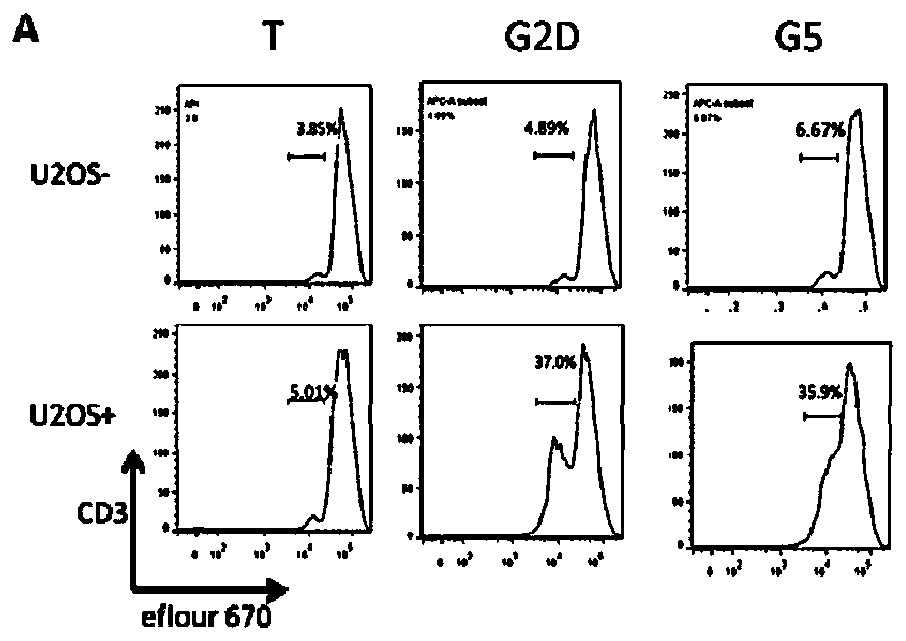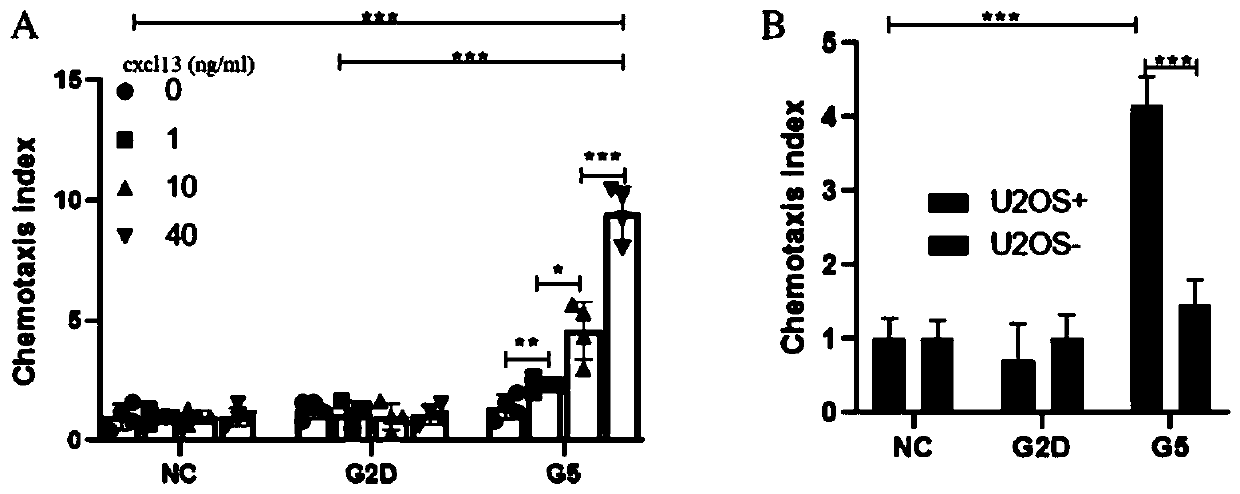Preparation and application of CXCL13 chemotaxis type CAR-T cells
A technology of immune cells and preparations, applied in the field of preparation and application of CXCL13 cytokine chemotactic CAR-T cells, which can solve the problem that CAR-T cells and tumor cells are difficult to contact closely
- Summary
- Abstract
- Description
- Claims
- Application Information
AI Technical Summary
Problems solved by technology
Method used
Image
Examples
Embodiment 1
[0285] Example 1 Construction of PCDH-NKG2D-CAR and PCDH-NKG2D-CXCR5-CAR vectors
[0286] The obtained NKG2D sequence (obtained from GenBank, NCBI Reference Sequence::AF461811.1) and CXCR5 sequence (obtained from GenBank, NCBI Reference Sequence: NM_032966.2) were linked together by overlapping PCR. After sequencing and identification, it was confirmed that the construction was successful, and the PLL3.7-NKG2D-CXCR5-CAR vector was obtained. The structure diagram is as follows figure 1 Shown: NKG2D-CXCR5-CAR was expressed using lentiviral expression system (the backbone plasmid is PLL3.7 plasmid), and the extracellular segment of NKG2D (containing exocrine signal peptide), CD8 transmembrane region and costimulatory factors were expressed using EF1a promoter 4-1BB is connected to the intracellular signal activation sequence CD3ζ, the back end is connected to T2A, and then connected to CXCR5, and the end uses PolyA stop codon.
Embodiment 2
[0287] Example 2 Preparation of CAR-T cells
[0288] Take human peripheral blood, use lymphocyte separation medium to separate human total lymphocytes, and use CD4 + , CD8 + Two kinds of magnetic beads were used to separate T lymphocytes, and CD3 and CD28 magnetic beads were used to activate T cells. After 48 hours, the medium was changed by centrifugation. Infect the lentivirus according to MOI=20:1, centrifuge and change the medium after 24 hours, add fresh medium, and detect the positive rate of T cells after staining with NKG2D antibody.
Embodiment 3
[0289] Example 3 CAR-T cell proliferation
[0290] T cells in the NC group, NKG2D-CAR-T (G2D) group and NKG2D-CXCR5-CAR-T (G5) group were labeled with eflour670 for 20 min, and then incubated with osteosarcoma cells U2OS respectively, and cell proliferation was detected by flow cytometry. After the cells are labeled with eflour670, the faster the cells proliferate, the lower the fluorescence intensity of the cells will be. The fluorescence intensity of the cells was detected by flow cytometry, and the stronger the fluorescence intensity, the frontier diagram would shift to the left. When CAR-T cells were co-incubated with target cells U2OS for 24 hours, the proliferation rate of the cells was significantly accelerated. Because T cells in the NC group cannot recognize specific tumor antigens, they cannot activate specific cell proliferation signals, and the fluorescence intensity of the cells is high, and the proliferation is slow ( figure 2 ). There was no significant diff...
PUM
 Login to View More
Login to View More Abstract
Description
Claims
Application Information
 Login to View More
Login to View More - R&D
- Intellectual Property
- Life Sciences
- Materials
- Tech Scout
- Unparalleled Data Quality
- Higher Quality Content
- 60% Fewer Hallucinations
Browse by: Latest US Patents, China's latest patents, Technical Efficacy Thesaurus, Application Domain, Technology Topic, Popular Technical Reports.
© 2025 PatSnap. All rights reserved.Legal|Privacy policy|Modern Slavery Act Transparency Statement|Sitemap|About US| Contact US: help@patsnap.com



